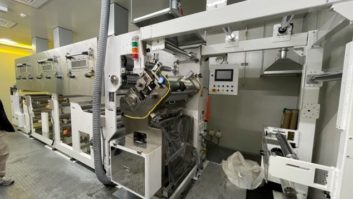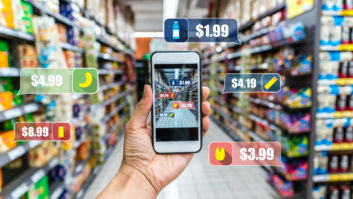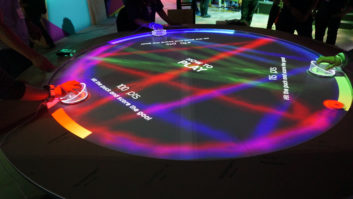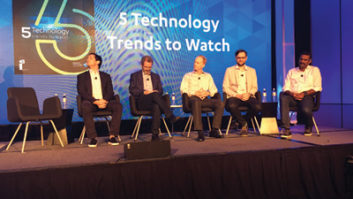
Everyone agrees that virtual and augmented reality (VR/AR) are exciting new technologies. But the questions floating around CES 2018 are whether VR and/or AR are capable of becoming truly disruptive technologies.
TWICE spoke to a number of VR/AR analysts about the present and future of these new technologies: ABI Research principal VR analyst Michael Inouye, IDC VP of devices and AR/VR Tom Mainelli, Parks Associates senior director of research Brett Sappington, Strategy Analytics executive director of apps and media David MacQueen, and IEEE senior member Vikram Kapila, a professor at the NYU Tandon School of Engineering.
Get this kind of CE coverage all year long — subscribe to the free TWICE eNewsletter.
TWICE: There seems to have been a radical re-thinking about the prospects for VR/AR. For instance, in August 2016, IDC projected VR/AR revenues would grow to $162 billion by 2020. But just a few months ago, IDC forecast VR/AR revenues of “just” $20 billion by 2021. What happened?
Mainelli, IDC: Broadly speaking, the VR market has underperformed people’s expectations to date. We have tried to be fairly conservative in our forecasts, but it has underperformed, which is why we saw the price cuts from HTC and Oculus.
Inouye, ABI: [But] there is too much momentum across industry players in the commercial, entertainment and consumer spaces to expect a redux of 3D TVs.
Kapila, IEEE: I view AR/VR in the same category as robotics, AI and block-chain-based contract technologies for its potential for disruption.
TWICE: Could another reason for disappointing consumer sales be the lack of compelling applications? What kinds of usage cases or apps unique to VR, not just gaming, might be coming to spur consumer interest?
Kapila, IEEE: There are start-ups building their technologies that combine robotics, 360 videos and VR for marketing high end real-estate or to create compelling online shopping experiences. One can also create tours of museums and such with this kind of technology.
Sappington, Parks: Virtual tours do have strong potential, but that is more of a business application, with consumers as the end customer, than it is a reason for consumers to buy VR hardware. HTC and Oculus have subsidized content creation to get out of this cycle, but their results have yet to cause mass market adoption.
Mainelli, IDC: Mainstream audiences are waiting for an experience they can’t live without. One of the things people will pay for is live sports in VR, but to capture, process and distribute sports is technically challenging. Once the technology and the story telling catches up, though, people will pay money to be on the [virtual] sideline and move around the huddle and all that stuff — that’ll be a driver. But a killer app is likely to be some kind of user collaboration to VR into a birthday party or be there for your parents’ anniversary — shared experiences, the things we want to do with our friends who aren’t in the same city. That has the potential to be the killer app. Mark Zuckerberg sees social as part of the shared experience.
MacQueen, Strategy Analytics: For me, AR has a far greater potential than VR, although in the long term I would expect the two technologies to merge into one. Why does AR have greater potential? VR is full immersion. You need to dedicate time, be in a safe environment, essentially pre-plan the activity. I don’t think VR will ever even get close to competing with TV or radio – you can’t have VR on “in the background” while you do something else. It’s not a casual experience. On the other hand, AR has utility for almost everything, overlaying useful and relevant information on the world around you. AR can be pervasive in a way that VR cannot.
TWICE: So what’s the prognosis for VR and AR in 2018, and beyond?
Inouye, ABI: 2018 could be a pivotal year for standalone VR HMDs, so I would definitely keep an eye on how this facet of the market develops and is received. Retailers and services could use events — for instance sporting events — to showcase VR. Ultimately though, 2018 shouldn’t be viewed as a make or break year for VR.
Sappington, Parks: We are seeing a slow increase in adoption for the next few years, with most of that growth occurring in mobile and console devices. Experiential stations will be important. For mass market, word-of-mouth will also be important, with consumers experiencing it through friends or destinations [such as] theme parks, etc.
Mainelli, IDC: Steven Spielberg’s new movie, “Ready Player One” — while a bit of a dystopian future and not an ideal calling card for VR — will certainly drive consumer interest in VR. But the movie is a double-edged sword; if Hollywood presents VR as this thing but the real-world experience doesn’t compare to what’s on the screen, that’ll be a problem. But I think that movie will probably drive some renewed interest.













